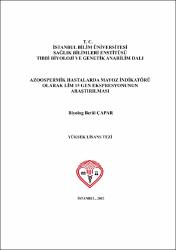| dc.contributor.advisor | Baltacı, Volkan | en_US |
| dc.contributor.author | Çapar, Betül | |
| dc.date.accessioned | 2015-02-09T08:28:36Z | |
| dc.date.available | 2015-02-09T08:28:36Z | |
| dc.date.issued | 2015 | |
| dc.date.submitted | 2015 | |
| dc.identifier.citation | Çapar, Betül. (2015). Azoospermik Hastalarda Mayoz İndikatörü olarak Lim 15 Gen Ekspresyonunun Araştırılması. Yayımlanmamış yüksek lisans tezi. İstanbul : İstanbul Bilim Üniversitesi, Sağlık Bilimleri Enstitüsü. | en_US |
| dc.identifier.uri | https://hdl.handle.net/11446/686 | en_US |
| dc.description | İstanbul Bilim Üniversitesi, Sağlık Bilimleri Enstitüsü, Tıbbi Biyoloji ve Genetik Ana Bilim Dalı Yüksek Lisans Programı | en_US |
| dc.description.abstract | Sperm hücreleri mayoz bölünme ile çoğalan hücrelerdir. Mayoz bölünmenin testis dokusunda aktif olduğunun gösterilmesi azospermik hastalarda sperm oluşumunun olup olmadığıyla ilgili önemli bir süreçtir.
DNA tamir sisteminde 100’den fazla gen rol oynar ve bu genlerin kodladığı proteinler tamir mekanizmalarında görev alırlar. DNA tamir mekanizmasında görevli olan proteinlerden olan Rec A proteini rekombinasyonel bir değiş tokuş işlemi ile hasarsız komplementer zincirde bulanan sekansı transfer eder. Ökaryotlarda iki tip Rec A gibi rekombinaz yapan protein mevcuttur: Lim15/Dmc1 ve Rad51. Bunlardan Rad51 hem mayotik hem de somatik hücrelerde eksprese olur ve DNA tamir mekanizmasında fonksiyonu vardır. Lim15 ise sadece mayoz aşamasında rekombinasyona dayalı DNA sentezinde görev alan bir proteindir. Ökaryotlarda yapılan çalışmalar Lim15 proteinin sadece mayoz bölünmeye spesifik hücrelerde ifade edildiğini göstermiş ve Lim15 proteinin RAD51 proteini ile mayoz aşamasında işbirliği yaptığını ortaya koymuştur. Bu iki proteinin ifadesi mayoz bölünme için kritik bir öneme sahiptir.
Bu çalışma ile azoospermik hastalardaki testiküler dokulardan alınan materyalde Lim15 geninin ekspresyon düzeyi incelenecektir. Söz konusu genin ekspresyonunun varlığı ile testis dokusunda spermatojenik aktivite (mayotik aktivite) arasında korelasyon araştırılacak, ayrıca ekspresyonun seviyesinin takibi ile hastanın tedaviye cevabı, yada tedavi ile spermatojenik aktivitesinde artış olup olmadığı araştırılacaktır. Çalışmada metaryal olarak azoospermi nedeniyle TESE operasyonu planlanan hastalardan alınan doku örnekleri kullanılacaktır. Dokulardan RNA izolasyonu yapılıp, real time ekspresyon kiti kullanılarak PZR testleri kurulacaktır. Böylece Lim15 geninin ekspresyon analizi testis dokusu içinde sperm yapımından sorumlu mayoz bölünmenin olup olmadığını ve dolayısıyla spermatogenez potansiyelinin var olup olmadığı ortaya koyabilecek ve azoospermik hastalarda tekrarlayan TESE denemeleri yerine spermatojenik aktivitenin takip edilerek bu bilgiler ışığında elektif TESE yapılmasını sağlayabilecektir.
Böylece spermatogenezi sağlamak amacıyla tedavi verilen hastanın verilen tedaviye (hormonal tedavilere) cevabının takip edilerek buna göre TESE planlanması sağlanabilecektir. | en_US |
| dc.description.abstract | Sperm cells proliferate by meiotic division. It is important to show that meiosis is active at the testis tissue. In order to determine whether there is spermatogenic activity in azospermic patients.
More than 100 genes take a role at the DNA repair mechanism. REC A protein, one of the proteins coded by these genes, works at the recombination switch and helps for a damage free transfer of complementary chain sequence. At eukaryotes, there are two REC A like proteins that work at recombinase stage: Lim15 and Rad51. Rad 51 is expressed at both meiotic and somatic cells and has a role at DNA repair mechanism. Lim15 is a protein that has a role at DNA synthesis depended on recombination at meiosis stage. Studies conducted on eukaryotes showed that Lim15 protein is expressed only at cells specific to meiotic division and showed that Lim15 protein co-works with RAD51 protein at meiosis stage. Expression of the both proteins has a critical importance during spermatogenesis.
With this project, the expression of Lim15 at testicular tissue from azospermic patients will be researched. The correlation between the expression of this gene and the spermatogenetic activity will be studied. Also, expression levels of the gene will be observed for the azoospermic patients who treated by hormone drugs, or if after the treatment is there an increase in the spermatogenic activity will be researched. At the study, testical tissue will be acquired from azospermic patients undergoing TESE operation.
RNA isolation will be done from tissue samples, PCR tests will be setup using real time expression kits. In this way, the presence of the gene responsible for the meiotic division for sperm production will be investigated. Also the potential for spermatogenesis will be studied. As a result, for azospermic patients, instead of recurrent TESE operations it could be possible to make an elective TESE operation follow the spermatogenic activity.
Therefore, by examining the responses to hormon replacement theraphy of the patient for Sermatogenesis, it will be possible to schedule a TESE operation accordingly. | en_US |
| dc.language.iso | tur | en_US |
| dc.publisher | İstanbul Bilim Üniversitesi, Sağlık Bilimleri Enstitüsü. | en_US |
| dc.rights | info:eu-repo/semantics/openAccess | en_US |
| dc.subject | Lim15 | en_US |
| dc.subject | azoospermi | en_US |
| dc.subject | mayoz bölünme | en_US |
| dc.subject | azoospermia | en_US |
| dc.subject | meiosis | en_US |
| dc.title | Azoospermik hastalarda mayoz indikatörü olarak Lim 15 Gen ekspresyonunun araştırılması | en_US |
| dc.title.alternative | Invastigation of LIM15 expression as a possible marker for meiotic divisions in azospermic males | en_US |
| dc.type | masterThesis | en_US |
| dc.department | DBÜ, Sağlık Bilimleri Enstitüsü, Tıbbi Biyoloji ve Genetik Ana Bilim Dalı | en_US |
| dc.contributor.authorID | TR57435 | en_US |
| dc.relation.publicationcategory | Tez | en_US |
| dc.identifier.yoktezid | 455003 | en_US |


















